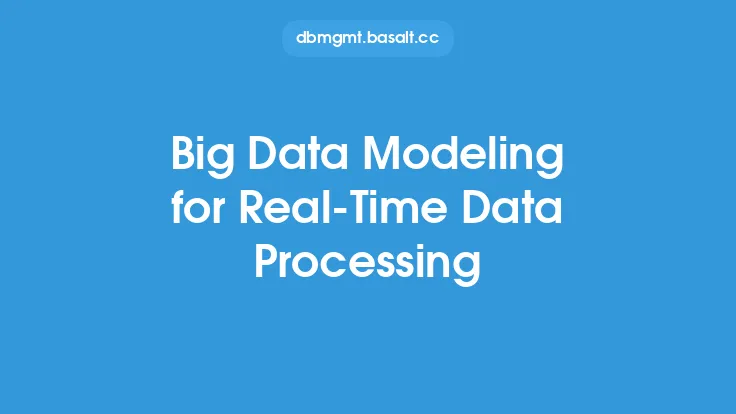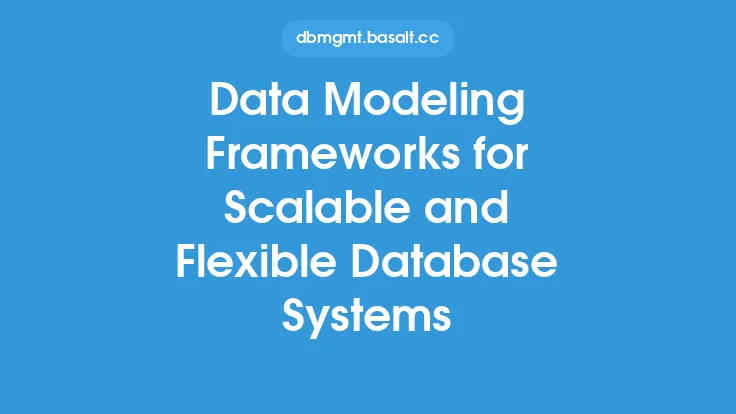Entity-Attribute-Value (EAV) modeling is a data modeling technique used to represent complex, sparse, and dynamic data in a flexible and scalable manner. This approach is particularly useful when dealing with data that has a large number of attributes, many of which may be null or empty, or when the data structure needs to be modified frequently. In traditional data modeling approaches, each entity is represented as a table with a fixed set of columns, which can lead to a rigid and inflexible data structure. EAV modeling, on the other hand, allows for a more flexible and dynamic representation of data, making it an attractive solution for many modern applications.
Introduction to EAV Modeling
EAV modeling is based on the concept of separating the entity, attribute, and value into separate tables. The entity table stores information about the entities, the attribute table stores information about the attributes, and the value table stores the actual values for each entity-attribute pair. This approach allows for a many-to-many relationship between entities and attributes, making it possible to represent complex and dynamic data structures. The EAV model consists of three main components: entities, attributes, and values. Entities are the objects or concepts being modeled, attributes are the characteristics or properties of the entities, and values are the actual data associated with each entity-attribute pair.
Benefits of EAV Modeling
EAV modeling offers several benefits, including flexibility, scalability, and improved data integrity. The flexibility of EAV modeling comes from its ability to handle dynamic and sparse data, making it an ideal solution for applications with constantly changing data structures. The scalability of EAV modeling is due to its ability to handle large amounts of data and its support for many-to-many relationships between entities and attributes. Improved data integrity is also a benefit of EAV modeling, as it allows for the enforcement of data constraints and rules at the attribute level, rather than at the entity level. Additionally, EAV modeling makes it easier to add or remove attributes from an entity, without having to modify the underlying data structure.
Components of EAV Modeling
The EAV model consists of three main tables: the entity table, the attribute table, and the value table. The entity table stores information about the entities, such as the entity ID, name, and description. The attribute table stores information about the attributes, such as the attribute ID, name, and data type. The value table stores the actual values for each entity-attribute pair, along with the entity ID and attribute ID. The value table is the core of the EAV model, as it stores the actual data associated with each entity-attribute pair. The entity and attribute tables serve as reference tables, providing additional information about the entities and attributes.
Implementing EAV Modeling
Implementing EAV modeling requires careful consideration of the data structure and the relationships between entities and attributes. The first step is to identify the entities and attributes that need to be modeled. Once the entities and attributes have been identified, the next step is to design the entity, attribute, and value tables. The entity table should include columns for the entity ID, name, and description, while the attribute table should include columns for the attribute ID, name, and data type. The value table should include columns for the entity ID, attribute ID, and value. The relationships between the tables should be established using foreign keys, with the entity ID and attribute ID serving as the primary keys.
Querying EAV Data
Querying EAV data can be complex, due to the dynamic and flexible nature of the data structure. There are several approaches to querying EAV data, including using SQL queries, using programming languages such as Python or Java, or using specialized EAV query languages. SQL queries can be used to retrieve data from the EAV tables, but they can become complex and difficult to maintain. Programming languages can be used to write custom queries and data retrieval logic, but they require a deep understanding of the EAV data structure. Specialized EAV query languages, such as Entity-Attribute-Value Query Language (EAVQL), provide a more intuitive and efficient way to query EAV data.
Challenges and Limitations of EAV Modeling
While EAV modeling offers several benefits, it also has some challenges and limitations. One of the main challenges is the complexity of querying EAV data, which can lead to performance issues and difficulties in maintaining the data structure. Another challenge is the potential for data inconsistencies and errors, due to the dynamic and flexible nature of the data structure. Additionally, EAV modeling can lead to data redundancy and duplication, if not implemented carefully. To overcome these challenges, it is essential to carefully design the EAV data structure, establish clear data governance policies, and use specialized query languages and tools.
Best Practices for EAV Modeling
To get the most out of EAV modeling, it is essential to follow best practices and guidelines. One of the most important best practices is to carefully design the EAV data structure, taking into account the entities, attributes, and values that need to be modeled. Another best practice is to establish clear data governance policies, including data validation, data normalization, and data security. Additionally, it is essential to use specialized query languages and tools, such as EAVQL, to simplify the querying and retrieval of EAV data. Finally, it is crucial to regularly monitor and maintain the EAV data structure, to ensure data consistency and integrity.
Real-World Applications of EAV Modeling
EAV modeling has a wide range of real-world applications, including healthcare, finance, and e-commerce. In healthcare, EAV modeling can be used to represent complex medical data, such as patient histories and treatment plans. In finance, EAV modeling can be used to represent dynamic and complex financial data, such as stock prices and trading volumes. In e-commerce, EAV modeling can be used to represent product information, such as product descriptions and pricing. Additionally, EAV modeling can be used in data warehousing and business intelligence applications, to provide a flexible and scalable data structure for analytics and reporting.
Conclusion
Entity-Attribute-Value modeling is a powerful and flexible data modeling technique, used to represent complex, sparse, and dynamic data. Its benefits include flexibility, scalability, and improved data integrity, making it an attractive solution for many modern applications. While EAV modeling has some challenges and limitations, it can be overcome by carefully designing the EAV data structure, establishing clear data governance policies, and using specialized query languages and tools. By following best practices and guidelines, organizations can get the most out of EAV modeling and improve their data management and analytics capabilities. As data continues to grow in complexity and volume, EAV modeling is likely to play an increasingly important role in data modeling and management.





